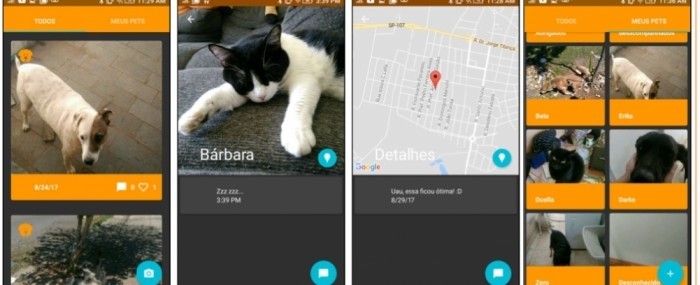
Smartphone app uses computer vision to identify animals
14 de novembro de 2017SciPet, a company incubated at the State University of Campinas (UNICAMP) in São Paulo State, Brazil, and formed in 2016, uses computer vision and artificial intelligence to identify animals.
The smartphone app "Crowdpet" is a result of a research carried out by SciPet with support from the Sao Paulo Research Foundation (FAPESP), through its Innovative Research in Small Business Program (PIPE). The product is designed to combine two data sources: photographs of lost animals registered by their owners and photographs of animals sighted in the street by volunteers.
"The app establishes a match between two images using computational visual recognition, and pinpoints by geolocation the place where the picture of the lost animal was taken," says Fabio Rogério Piva, who is the CEO of SciPet and has a PhD in computer science from UNICAMP.
"Crowdpet" is already in use by the municipality of Vinhedo, a city in the surroundings of Campinas. With the aid of the app, identification and registration are being performed by the city's Center for Animal Disease Control. The initiative, part of a census of animals reached by vaccination campaigns started in July, has the purpose of maintaining an up-to-date registry, above all for control of lost and abandoned animals in the streets.
At the end of Stage 1 of the PIPE project, during which its feasibility was analyzed, SciPet completed a prototype capable of distinguishing cats and dogs from all other images with a 99% success rate. "Even if a user photographs people or objects, the system will register only photos of animals," Piva explains.
The researcher explains that the SciPet studies stand as one of the first attempts to apply biometry to animals. "It showed that human facial biometry methods aren't very effective to identify dogs. Using a method specially developed for animals, they achieved 89% accuracy, equivalent to the success rate obtained by a human observer who specializes in dogs."
Accurate and single recognition
The research project, which was selected among finalists for the 2017 awards of UNICAMP's incubator agency (the Inova UNICAMP Prize), is preparing itself for an even more complex challenge - obtaining the accurate identification of each animal.
Piva states it still takes a long way until the prototype is able to satisfy all the real conditions for use of the CrowdPet app. He refers to the project called "Where is my puppy? Retrieving lost dogs by facial features", which form the basis for the firm's first studies. The project was conducted by researchers at UNICAMP's Reasoning for Complex Data Laboratory (ReCoD Lab), with Professor Eduardo Valle as principal investigator. Valle is currently working with SciPet.
"The study was based on photos taken with the animal always in the same position and at the same distance, i.e., centered. We have to work with photos taken in the street, in different positions, and with varying lighting conditions," Piva says.
Moreover, the state of the lost animal may also influence visual recognition, as it may be dirty or injured. It will, therefore, be necessary to have several photos of the same animal - and not just of its head but of the whole body, given that a characteristic mark on any part of the body could be decisive for recognition.
"The next step will be to reproduce the experiments described in the article 'Where is my puppy?' using photos taken in the wild. This is our biggest challenge," Piva says. To surmount it, SciPet will be assisted by Professor Anderson Rocha as an associate researcher. Rocha is a specialist in machine learning for image recognition.
Redirecting the business plan
The first version of SciPet's business plan for CrowdPet chose people who wanted to find missing pets, connected in a kind of "social network", as its sole target clientele. However, before completing Stage 1 of PIPE, SciPet was selected to take part in the Fourth Edition of FAPESP's Training Program for High-Tech Entrepreneurs between July 31 and September 19, 2017.
During the training program, the SciPet team interviewed over 100 prospective customers. This listening and market prospection exercise showed that city governments needed to conduct a census before they could control the population of abandoned animals. "This is an unsolved problem. It's hard to avoid double counting. Some cities use microchips, but the process involved is costly," Piva says.
At that point, the firm made the strategic decision of offering the app to local government so that cities could provide a street animal monitoring service. "Besides Vinhedo, we're also in touch with several other cities that are setting up animal welfare departments," Piva says.
Cities are now considered the main partners for the project. "CrowdPet can be offered free of charge to the public through local government," he explains. "We refined the concept and realized we wouldn't be able to make a 'pet solution' work."
Piva plans to add more functionality in future, including registration of volunteers and animal protection associations, lists of animals available for adoption, and rewards for people who find lost animals.
###
Also published at Eurekalert: www.eurekalert.org/pub_releases/2017-12/fda-sau122017.php
